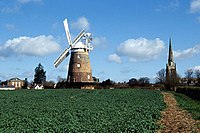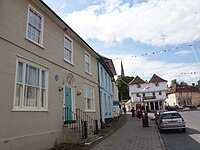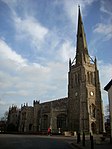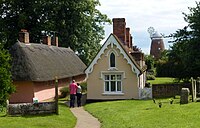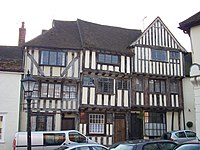Thaxted: Difference between revisions
Created page with '{{Infobox town |name=Thaxted |county=Essex |picture=Thaxted guildhall.JPG |picture caption=Thaxted Guildhall |os grid ref=TL615315 |latitude=51.9544 |longitude=0.3461 |population…' |
No edit summary |
||
| Line 24: | Line 24: | ||
Thaxted's population has remained almost unchanged down the centuries, hovering near the 2,000 mark. In 1829 there were 2,293 people living in Thaxted; in 1848 there were 2,527. At the time of the 1881 census that figure had fallen to 1,914, and fell further by 1921 to 1,596.<ref>Mark Arman. 1978. ''An Historical Guide and brief tour of the Ancient Town of Thaxted in Essex''. [Published by author], ISBN 0-946943-00-1.</ref> In 2001, the population was 2,526. | Thaxted's population has remained almost unchanged down the centuries, hovering near the 2,000 mark. In 1829 there were 2,293 people living in Thaxted; in 1848 there were 2,527. At the time of the 1881 census that figure had fallen to 1,914, and fell further by 1921 to 1,596.<ref>Mark Arman. 1978. ''An Historical Guide and brief tour of the Ancient Town of Thaxted in Essex''. [Published by author], ISBN 0-946943-00-1.</ref> In 2001, the population was 2,526. | ||
The composer Gustav Holst was a long term resident. Holst's setting of the patriotic hymn "I Vow to Thee, My Country" to the trio melody of "Jupiter" in ''The Planets'' is named after the town. | The composer Gustav Holst was a long-term resident. Holst's setting of the patriotic hymn "I Vow to Thee, My Country" to the trio melody of "Jupiter" in ''The Planets'' is named after the town. | ||
==Parish church== | ==Parish church== | ||
The large parish church of St John, built between 1340 and 1510, is renowned for its flying-buttressed spire, which is 181 feet tall and is the only mediæval stone spire in the county.<ref>http://www.thaxted.co.uk/?History_of_Thaxted:Thaxted_Parish_Church</ref> It has | The large parish church of St John, built between 1340 and 1510, is renowned for its flying-buttressed spire, which is 181 feet tall and is the only mediæval stone spire in the county.<ref>http://www.thaxted.co.uk/?History_of_Thaxted:Thaxted_Parish_Church</ref> It has perpendicular windows and a stained glass representing Adam and Eve. The church, which stands on a hill and overlooks the town, is often referred to as "the Cathedral of Essex".<ref name="EL0908">{{cite journal|last=Ward|first=Amy|date=September 2008|title=A Centre for Culture|journal=Essex Life|publisher=Archant|pages=94|url=http://edition.pagesuite-professional.co.uk/Launch.aspx?referral=other&pnum=&refresh=Xx310Ki2Lg80&EID=ae1ff680-f48b-4a38-9931-2ac69df9011d&skip=true|accessdate=24 January 2009}} (Registration required).</ref> | ||
==Sights of the town== | ==Sights of the town== | ||
Notable Thaxted buildings include: | Notable Thaxted buildings include: | ||
*Horham Hall | *[[Horham Hall]] | ||
*Thaxted Guildhall dating from around 1450 | *Thaxted Guildhall dating from around 1450 | ||
*John Webb's Windmill built in 1804. | *[[John Webb's Windmill]] built in 1804. | ||
<gallery widths="200" heights="150"> | <gallery widths="200" heights="150"> | ||
Latest revision as of 12:01, 20 December 2017
| Thaxted | |
| Essex | |
|---|---|
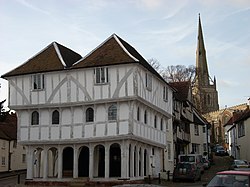 Thaxted Guildhall | |
| Location | |
| Grid reference: | TL615315 |
| Location: | 51°57’16"N, -0°20’46"E |
| Data | |
| Population: | 2,526 (2001) |
| Post town: | Dunmow |
| Postcode: | CM6 |
| Dialling code: | 01371 |
| Local Government | |
| Council: | Uttlesford |
| Parliamentary constituency: |
Saffron Walden |
Thaxted is a town in the green heart of Essex, a modest place of some 2,500 souls.
Thaxted appears in the Domesday Book of 1086 as Tachesteda, from Old English words assumed to mean "place whence thatch was fetched." Once a centre of cutlery manufacture, Thaxted went into decline with the rise of Sheffield as a major industrial centre.
A light railway, the Elsenham & Thaxted Light Railway, eventually opened in 1913, though the railway itself never reached nearer than three-quarters of a mile from the town, as building earthworks across the River Chelmer proved too costly. With the growth of road transport, the line was closed to passengers in 1952 and closed altogether in 1953. The name of Cutler's Green, a small hamlet about a mile to the west of Thaxted, recalls the trade that yielded the area's early wealth.
Population
Thaxted's population has remained almost unchanged down the centuries, hovering near the 2,000 mark. In 1829 there were 2,293 people living in Thaxted; in 1848 there were 2,527. At the time of the 1881 census that figure had fallen to 1,914, and fell further by 1921 to 1,596.[1] In 2001, the population was 2,526.
The composer Gustav Holst was a long-term resident. Holst's setting of the patriotic hymn "I Vow to Thee, My Country" to the trio melody of "Jupiter" in The Planets is named after the town.
Parish church
The large parish church of St John, built between 1340 and 1510, is renowned for its flying-buttressed spire, which is 181 feet tall and is the only mediæval stone spire in the county.[2] It has perpendicular windows and a stained glass representing Adam and Eve. The church, which stands on a hill and overlooks the town, is often referred to as "the Cathedral of Essex".[3]
Sights of the town
Notable Thaxted buildings include:
- Horham Hall
- Thaxted Guildhall dating from around 1450
- John Webb's Windmill built in 1804.
-
Thaxted Windmill and Church
-
The Manse where Gustav Holst lived from 1917 to 1925
-
Parish church of St John
-
Almshouses at the church, with the sailless John Webb's Windmill in the background
-
Dick Turpin's cottage
Society and leisure
Thaxted has many clubs and societies. Thaxted Morris was founded in 1911 and is the oldest revival Morris dancing group in Britain.[3] Thaxted Morris Men hosted the meeting at which the "Morris Ring" was formed as a national organisation in 1934; and continue to host one of their meetings every year: in 2009 this was a celebration of the Ring's 75th anniversary.
The annual Thaxted festival takes place over four weekends in June and July every year, presenting a programme of musical concerts.[3]
The town was used for many of the exterior scenes in the 1952 comedy film Time Gentlemen Please.
In late 2010 and into early 2011, the town's recreation ground play park was redone. It now provides children with new equipment such as swings, a zip wire, a climbing frame and much more.
Thaxted also has its own football club who are known as the Thaxted Rangers, they have a senior team as well as several youth teams.
Outside links
| ("Wikimedia Commons" has material about Thaxted) |
- Thaxted Church on Essex Churches website
- Pictures and information on Thaxted station from Subterranea Britannica
References
- ↑ Mark Arman. 1978. An Historical Guide and brief tour of the Ancient Town of Thaxted in Essex. [Published by author], ISBN 0-946943-00-1.
- ↑ http://www.thaxted.co.uk/?History_of_Thaxted:Thaxted_Parish_Church
- ↑ 3.0 3.1 3.2 Ward, Amy (September 2008). "A Centre for Culture". Essex Life (Archant): 94. http://edition.pagesuite-professional.co.uk/Launch.aspx?referral=other&pnum=&refresh=Xx310Ki2Lg80&EID=ae1ff680-f48b-4a38-9931-2ac69df9011d&skip=true. Retrieved 24 January 2009. (Registration required).
